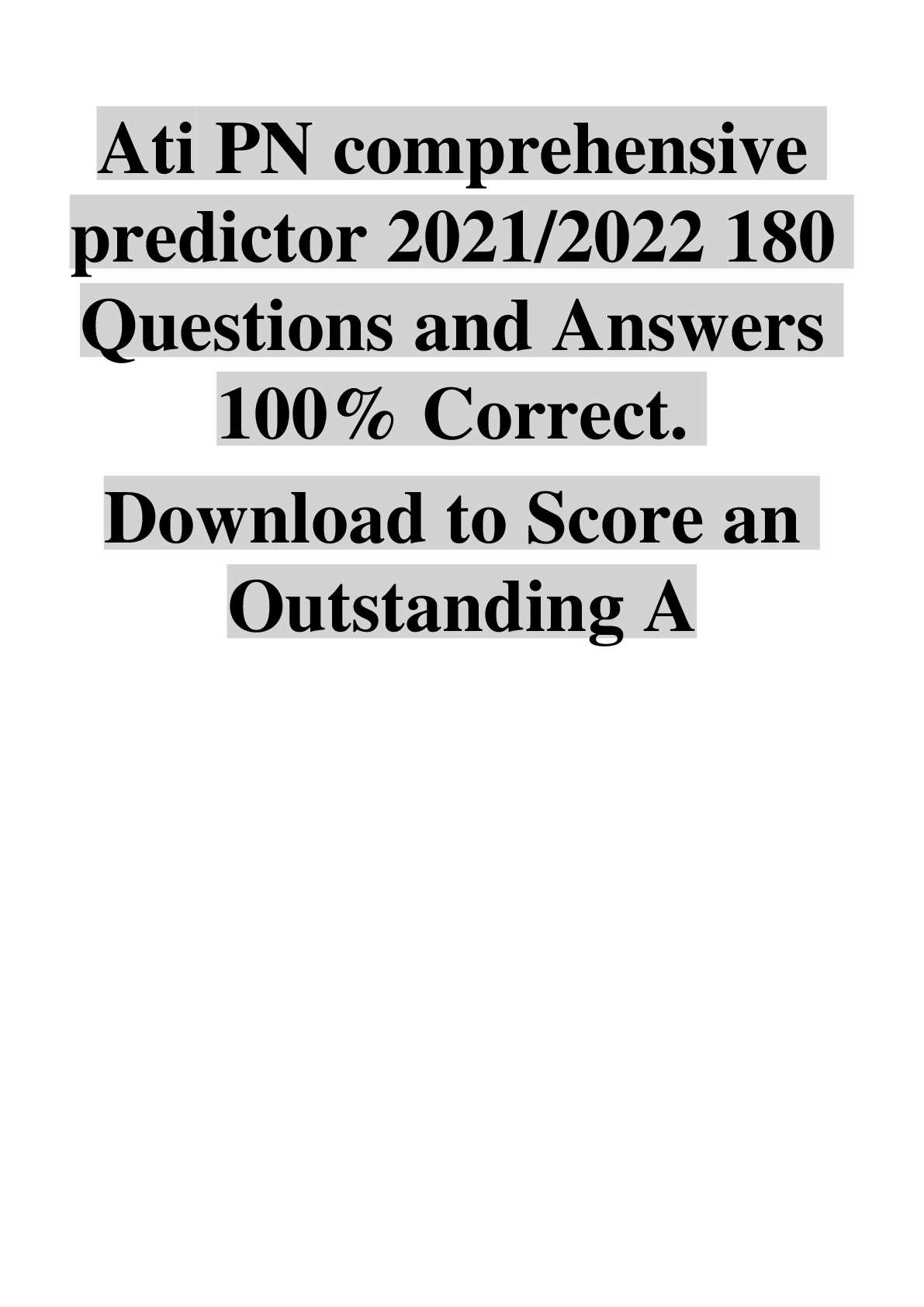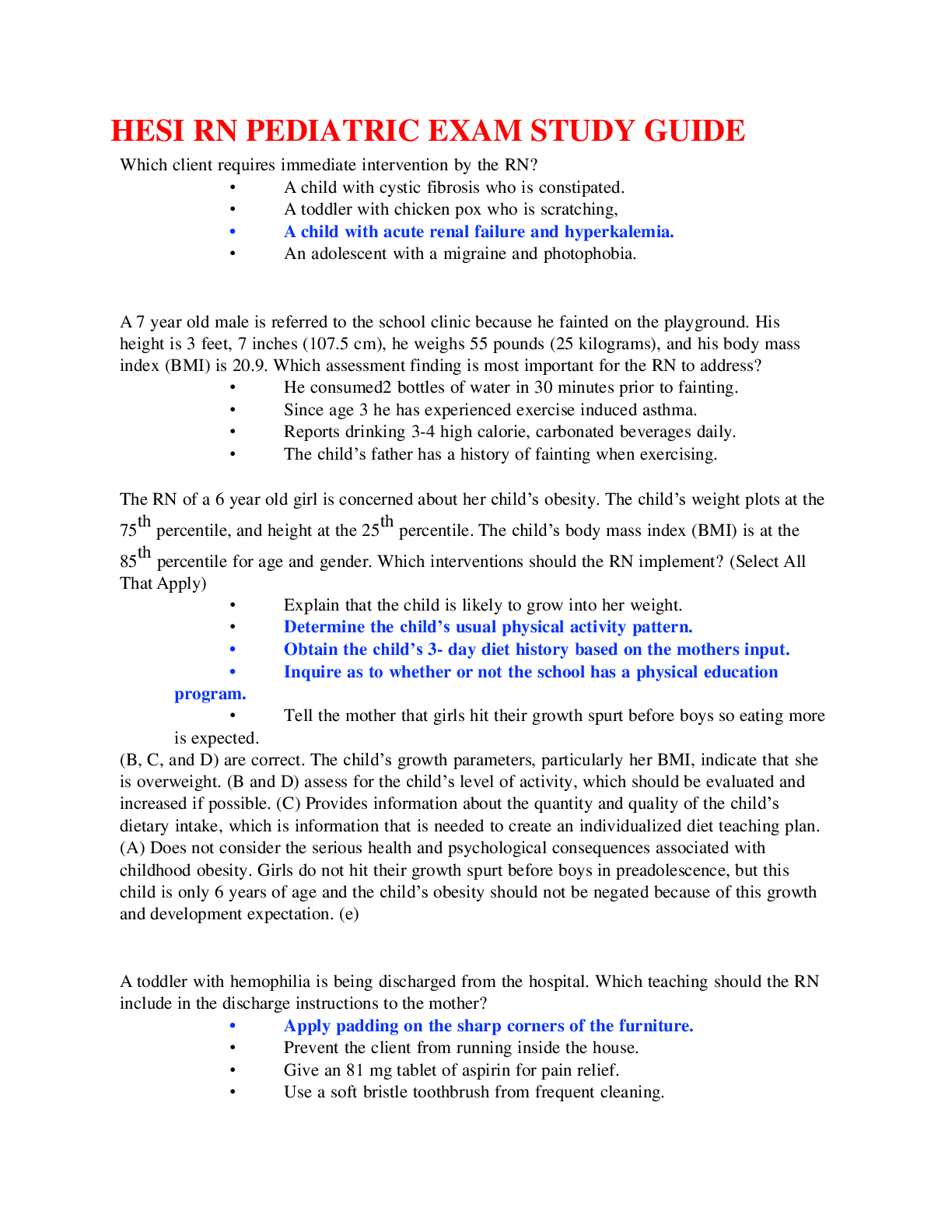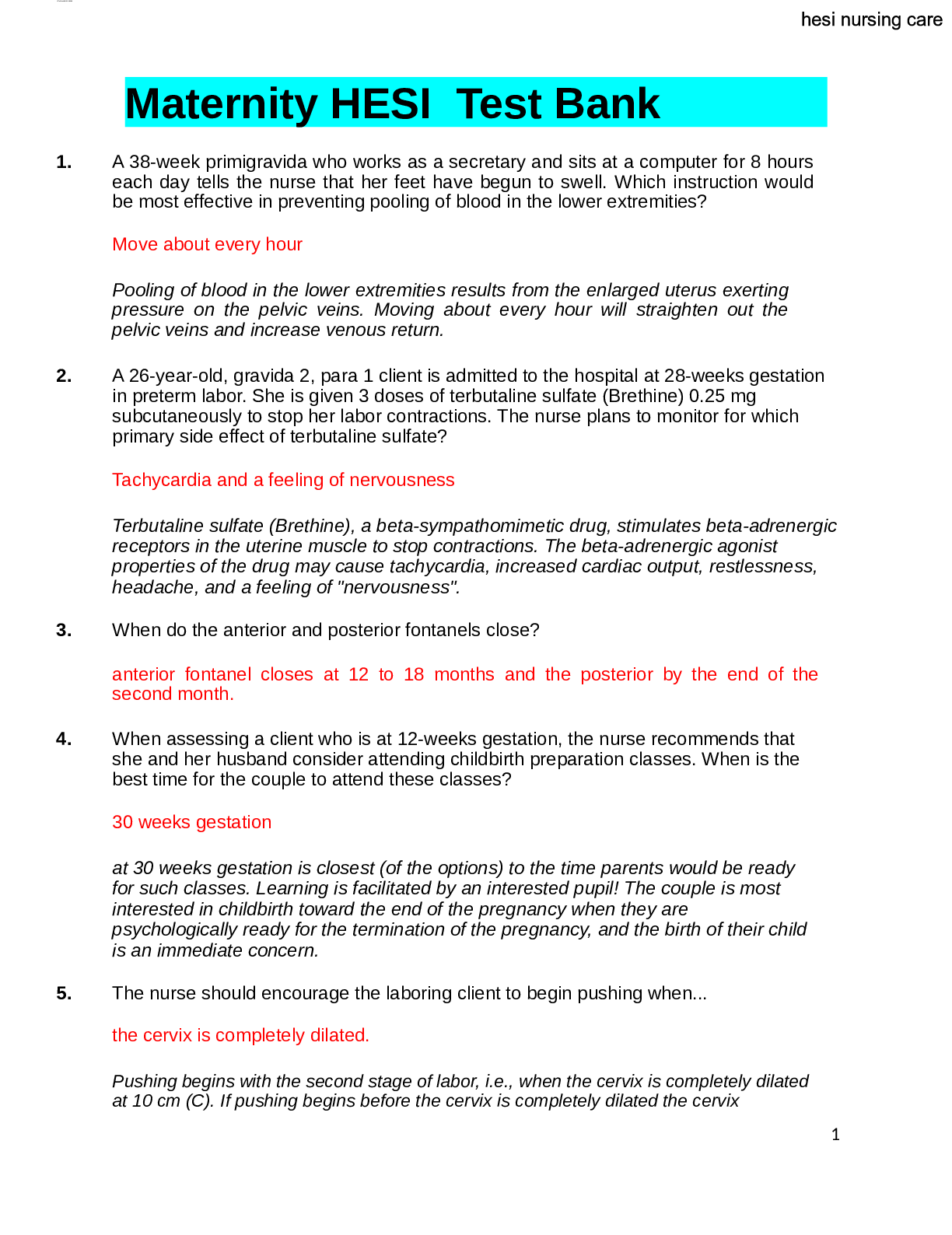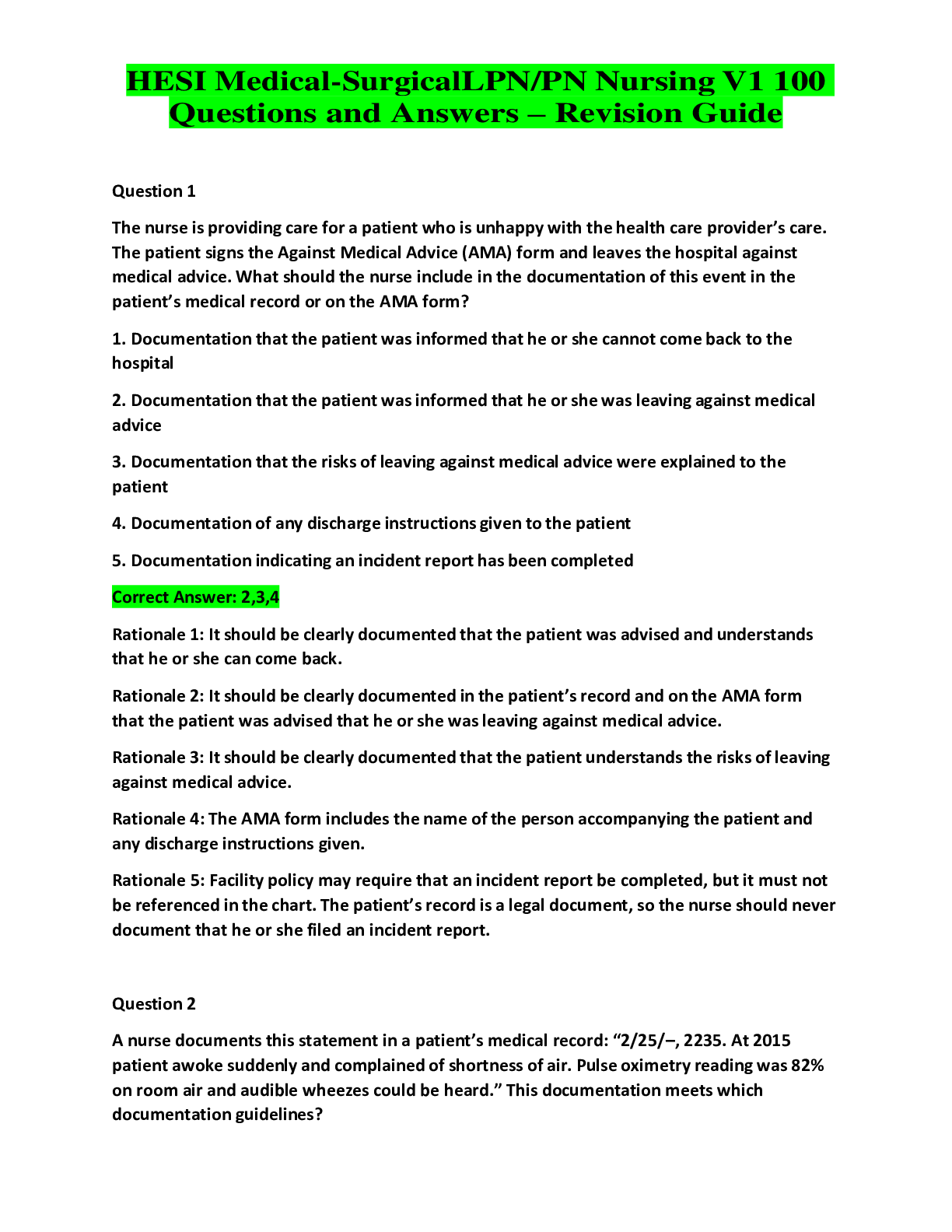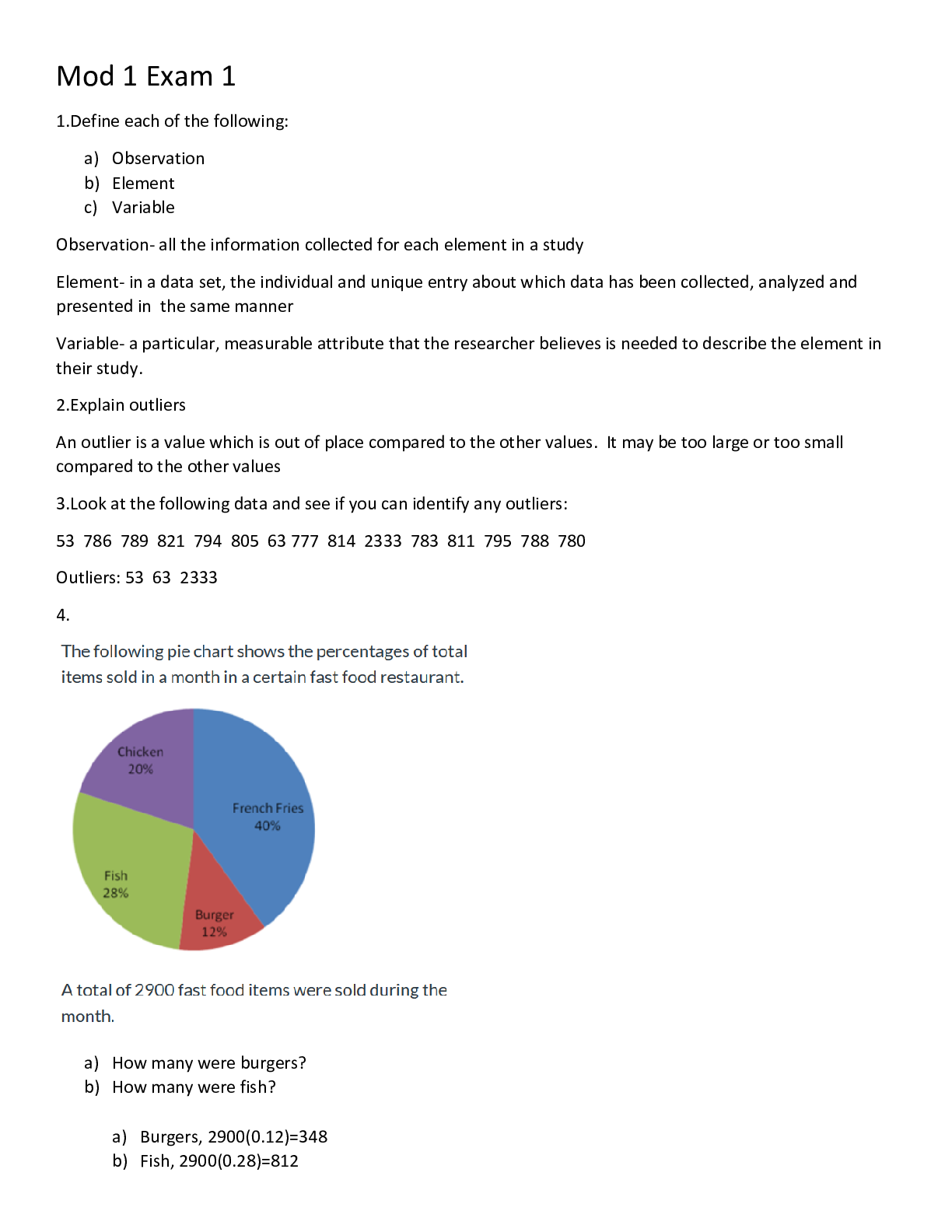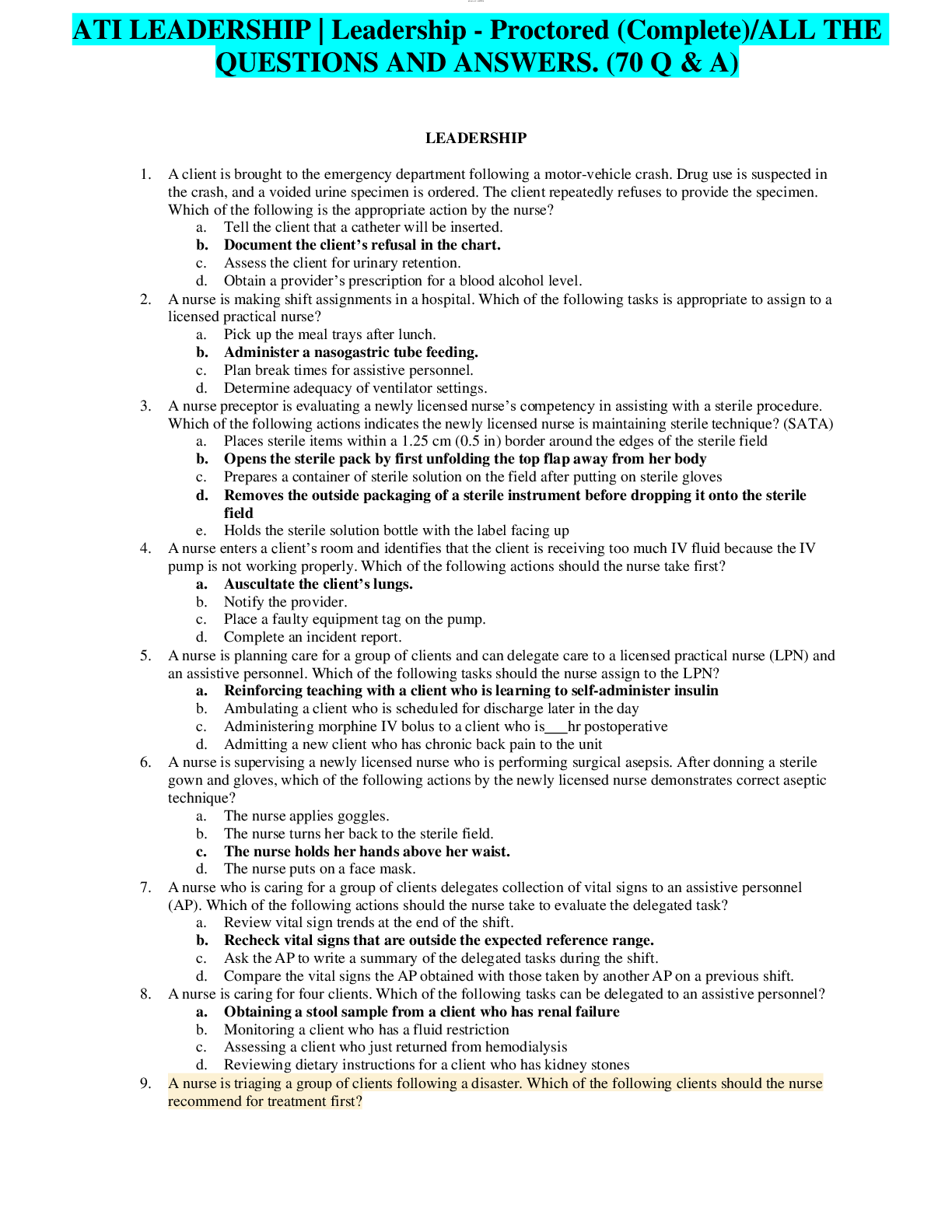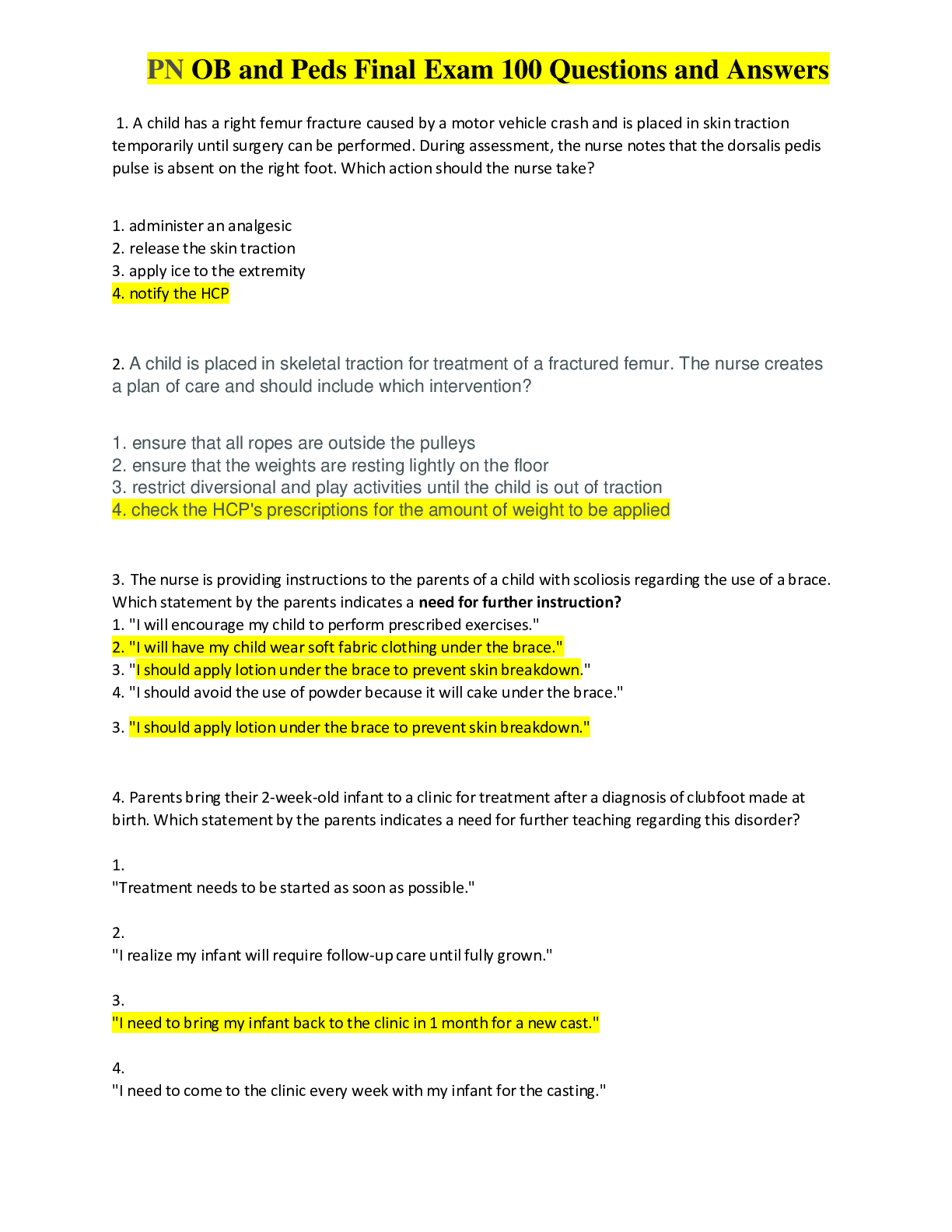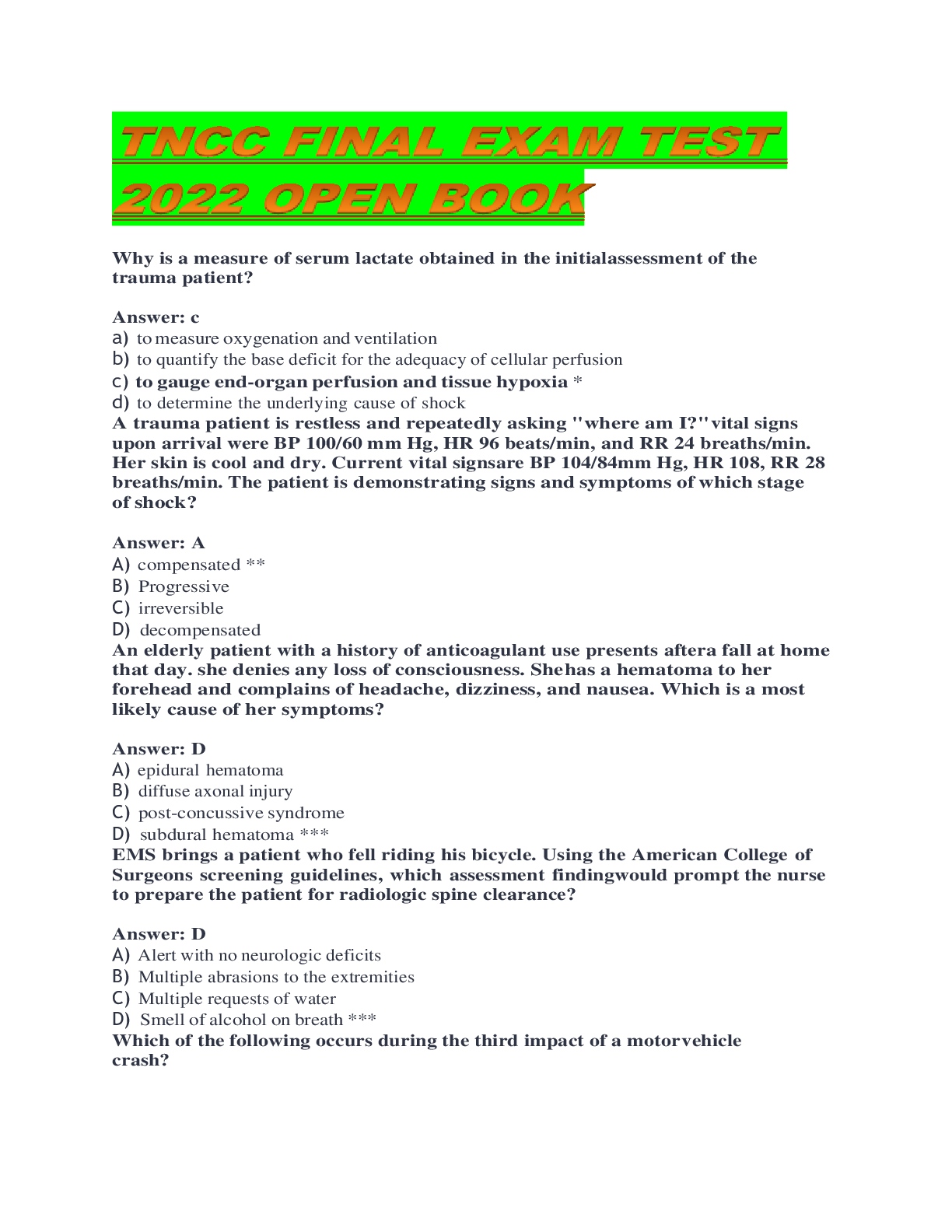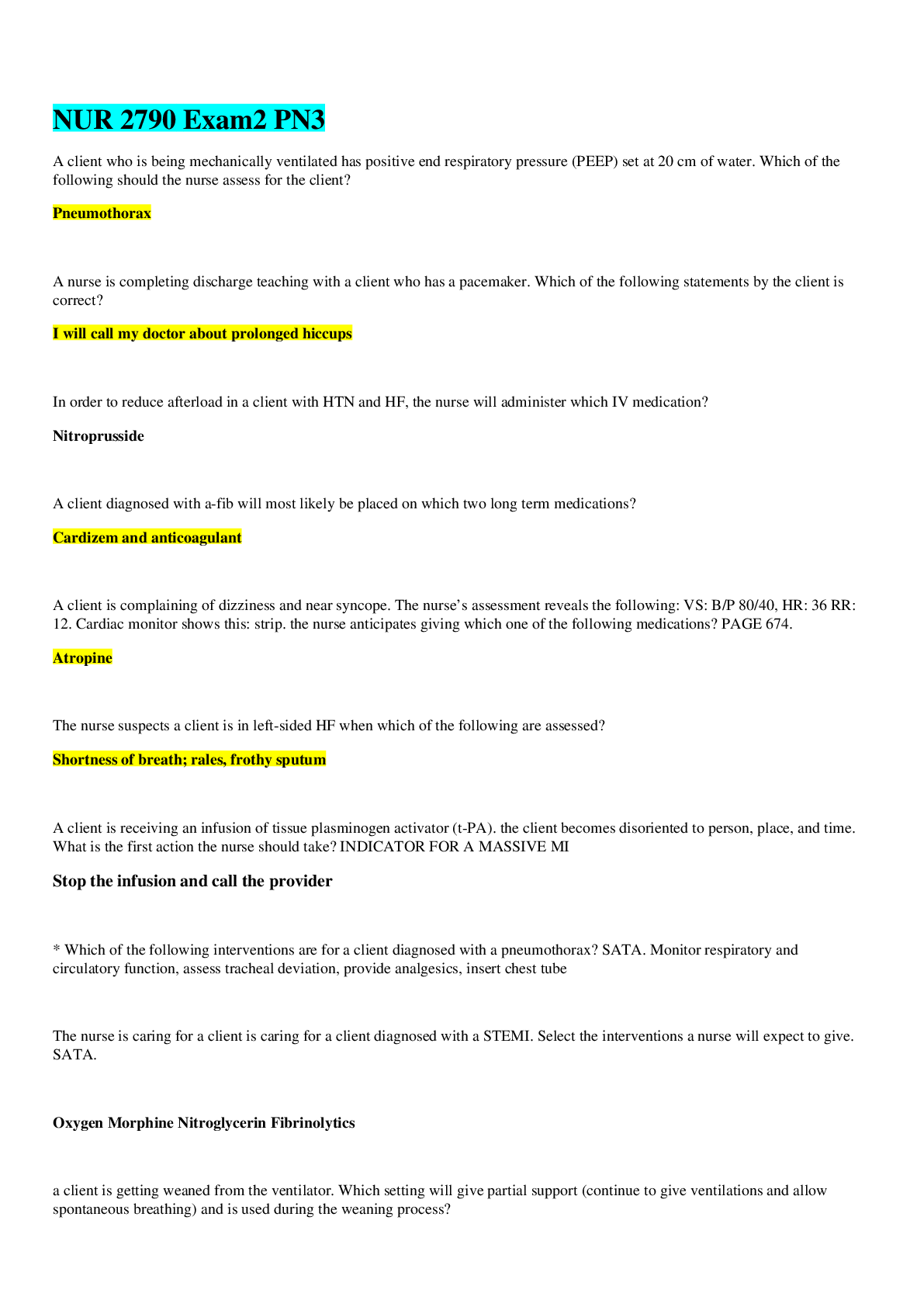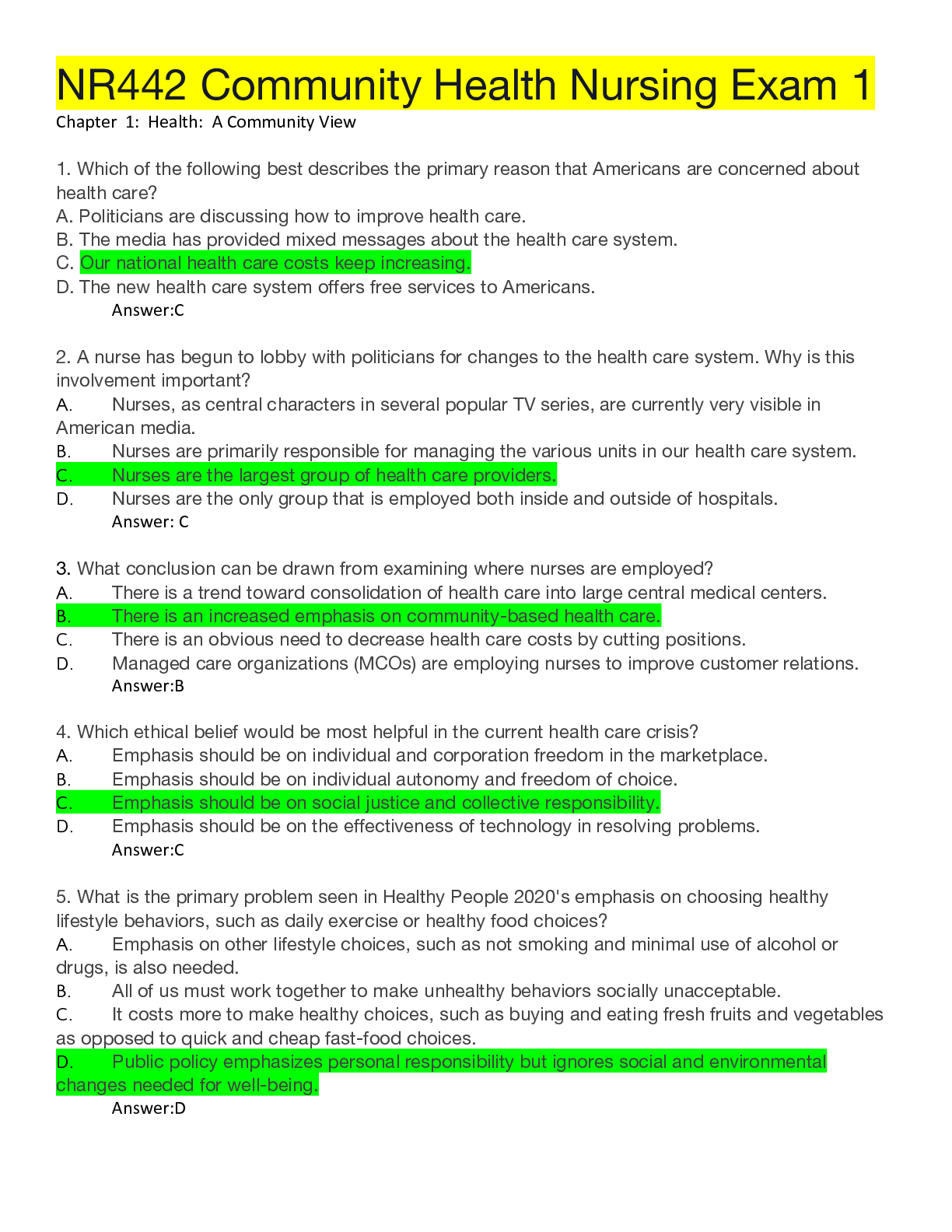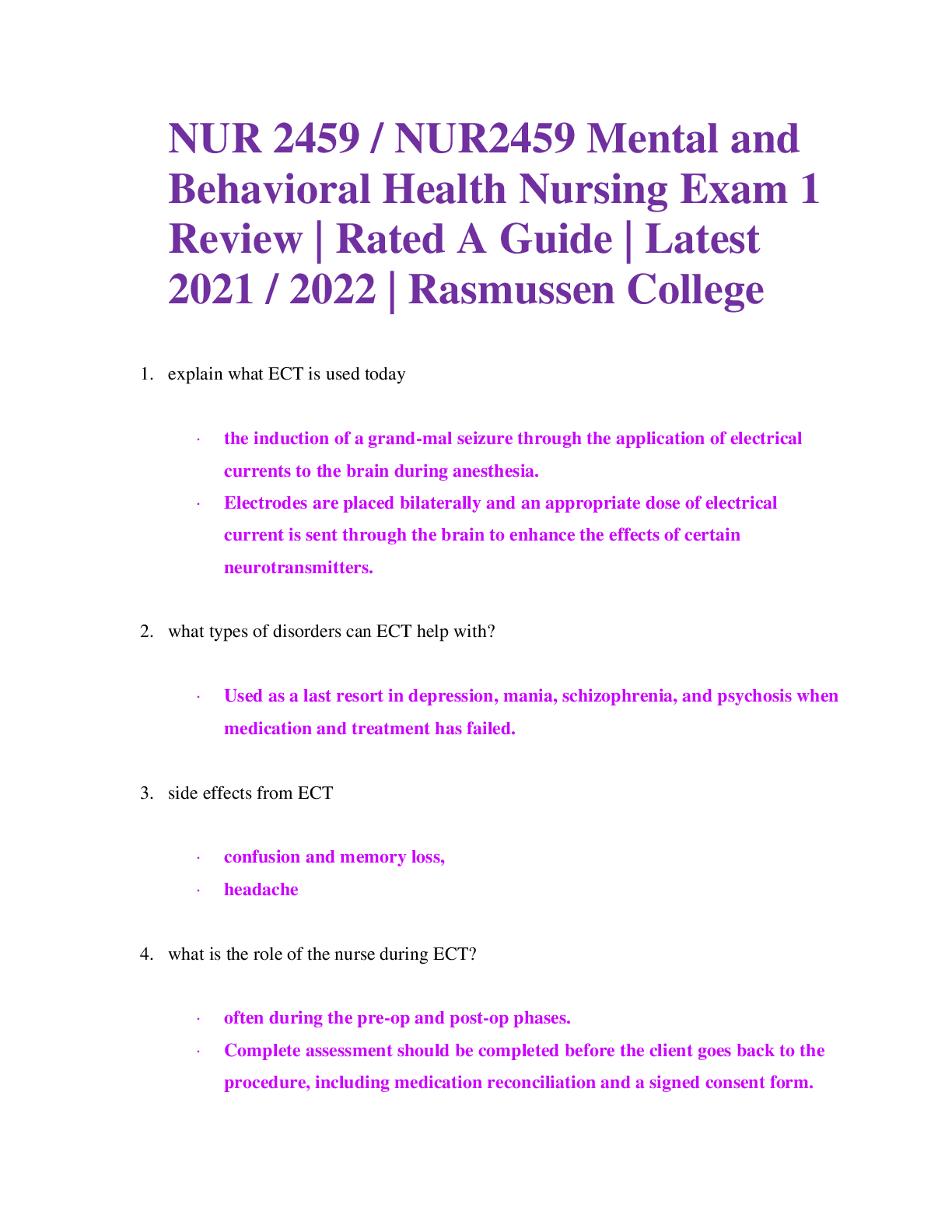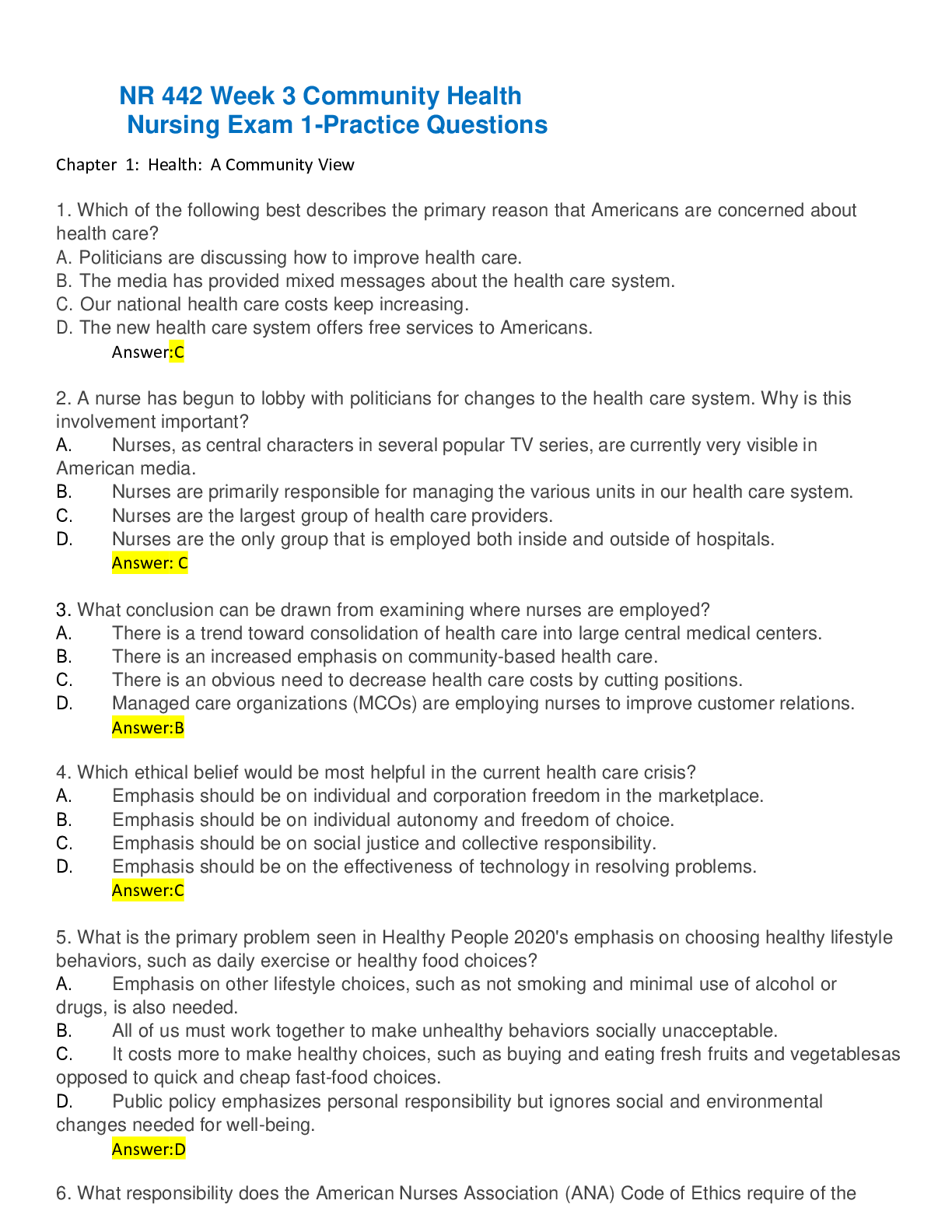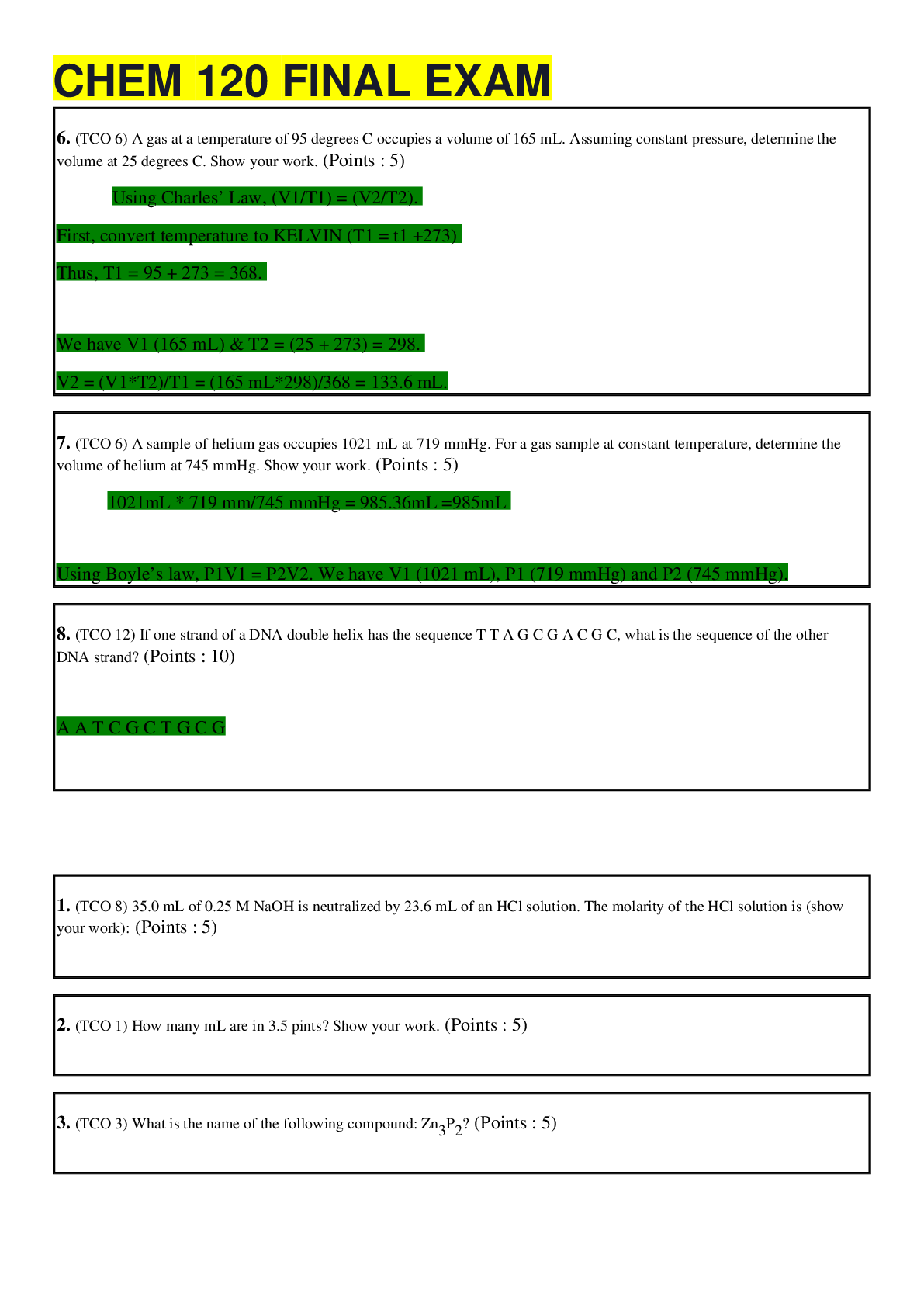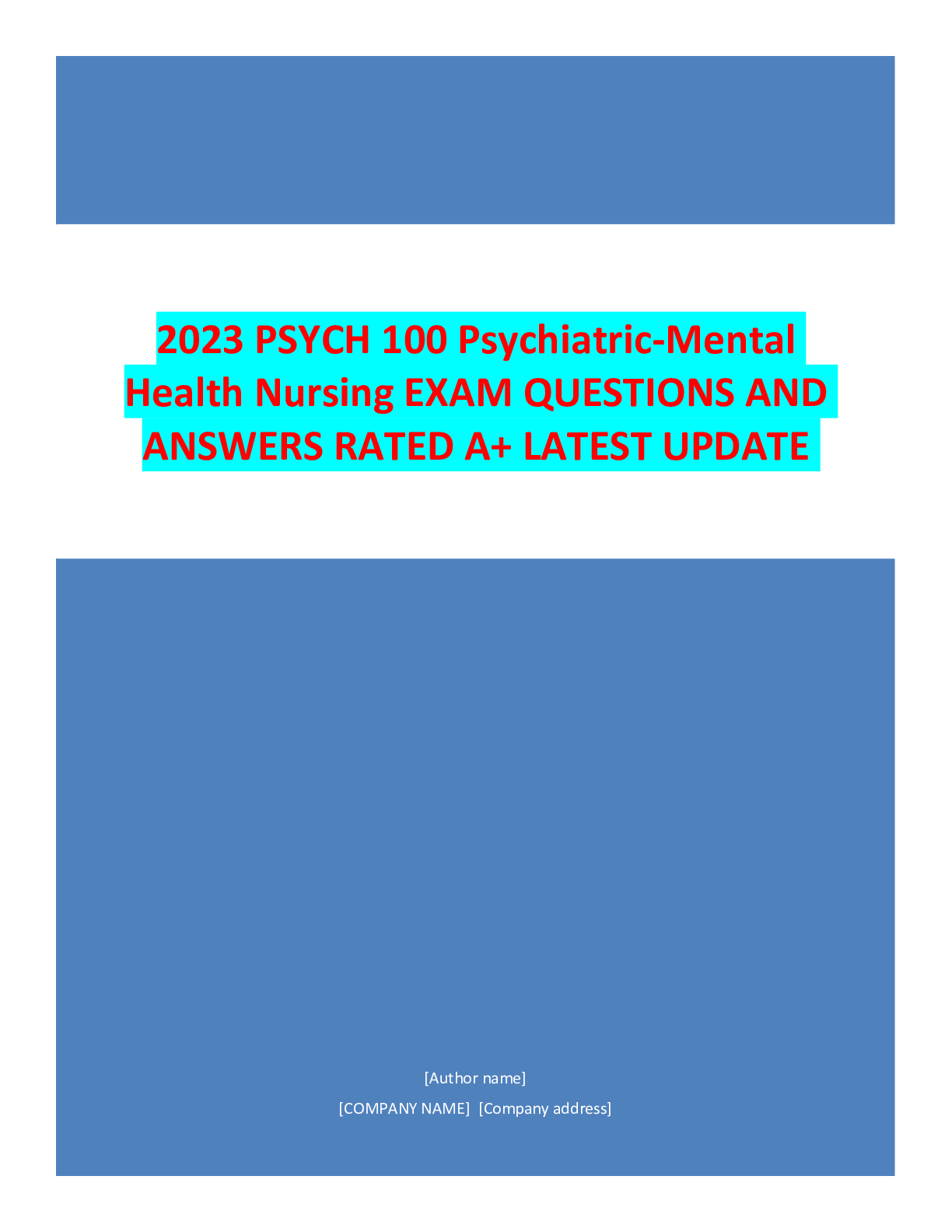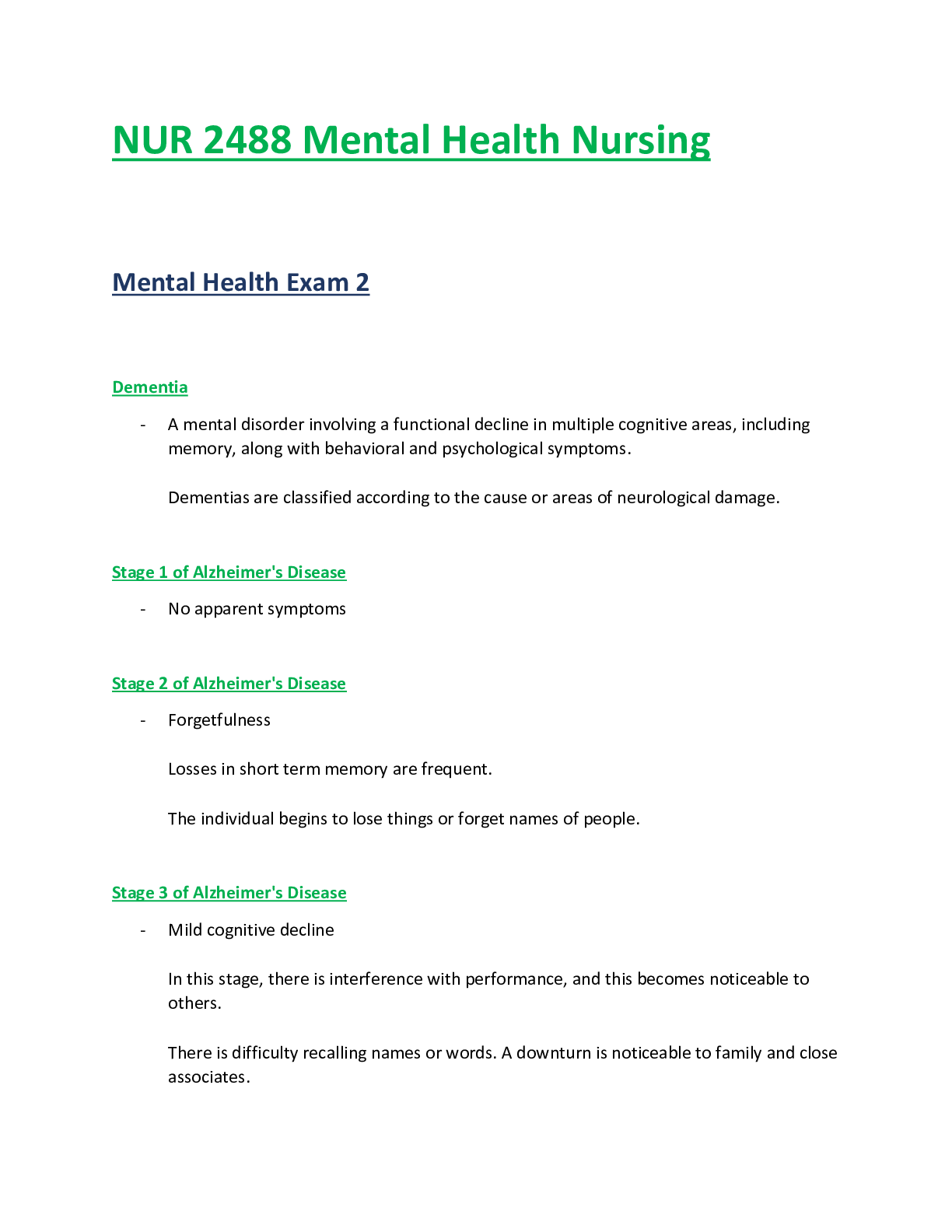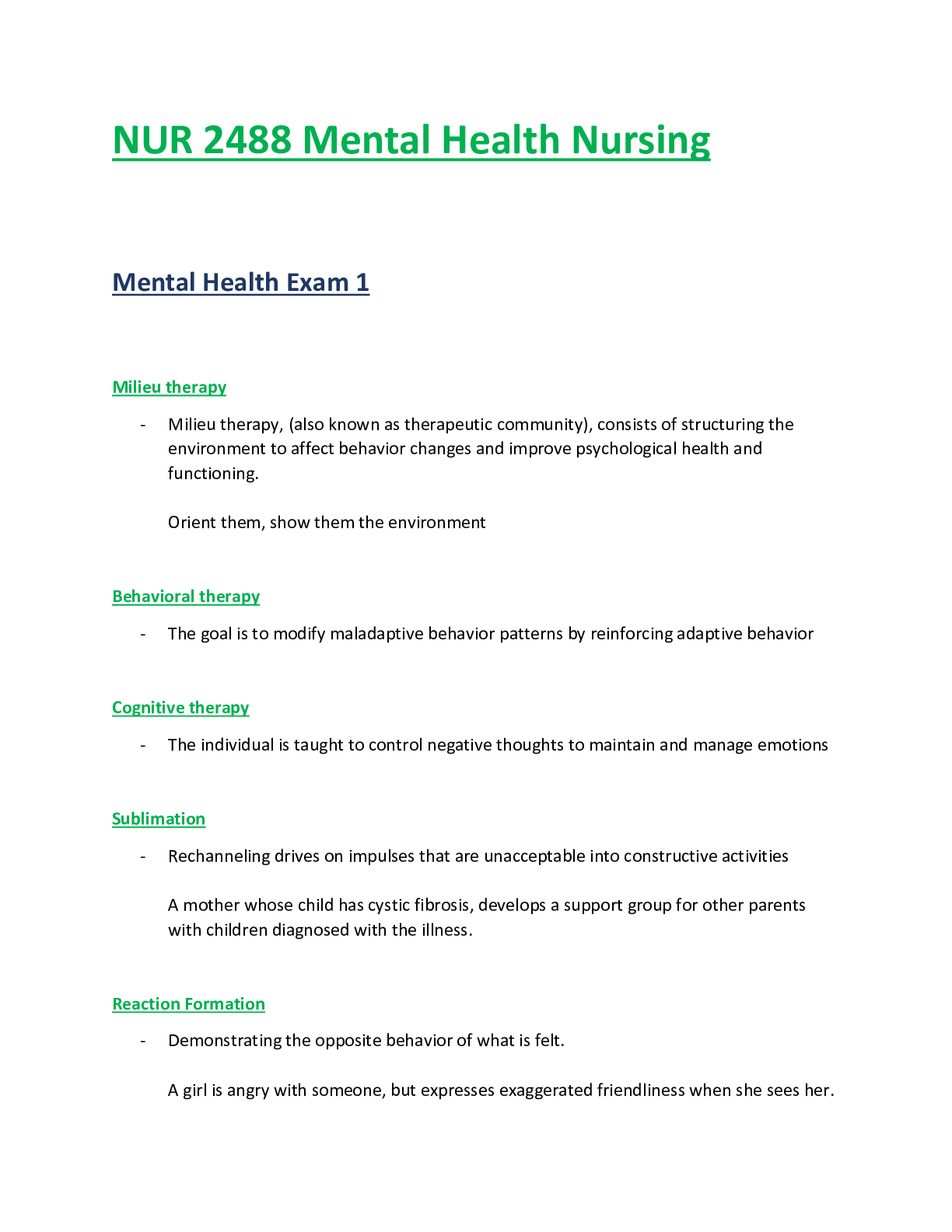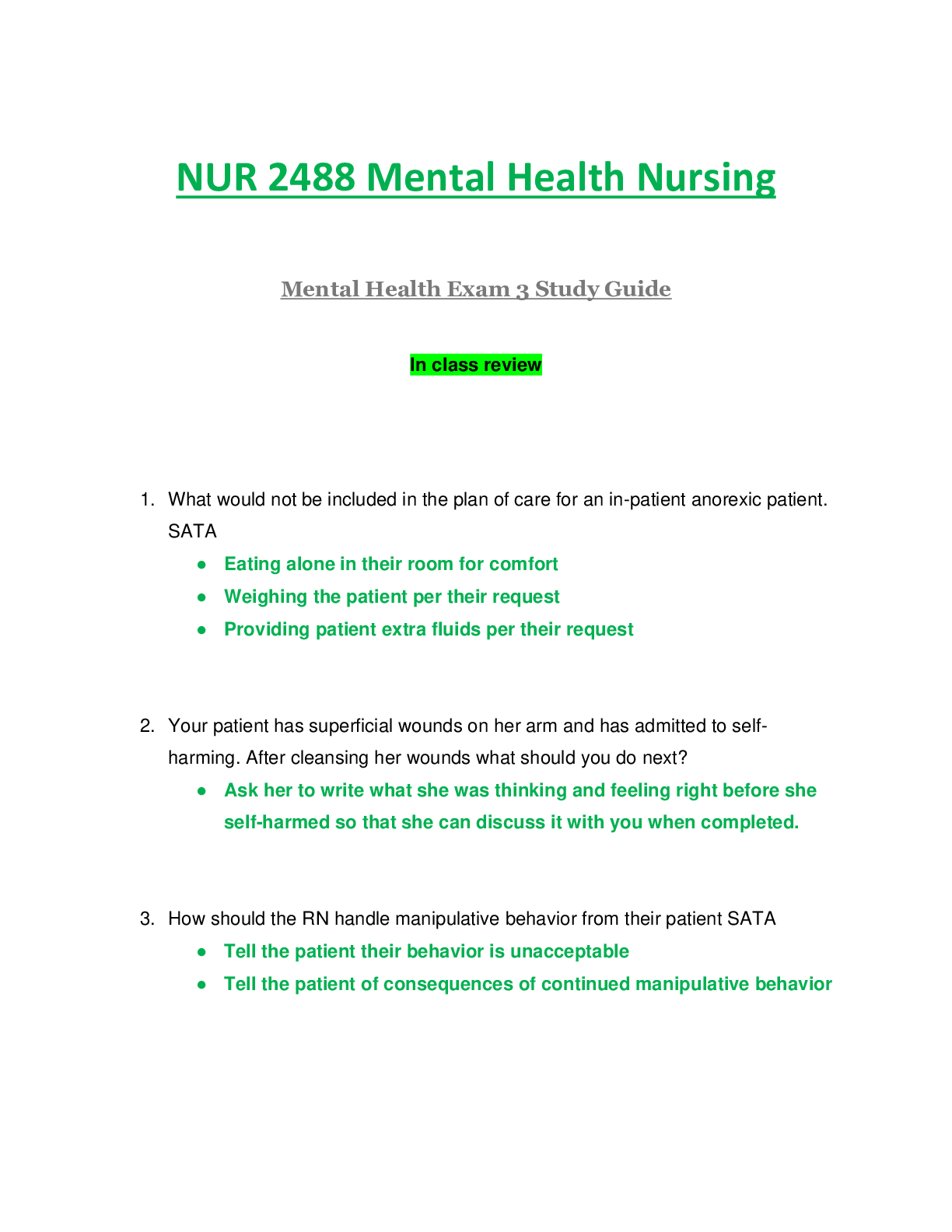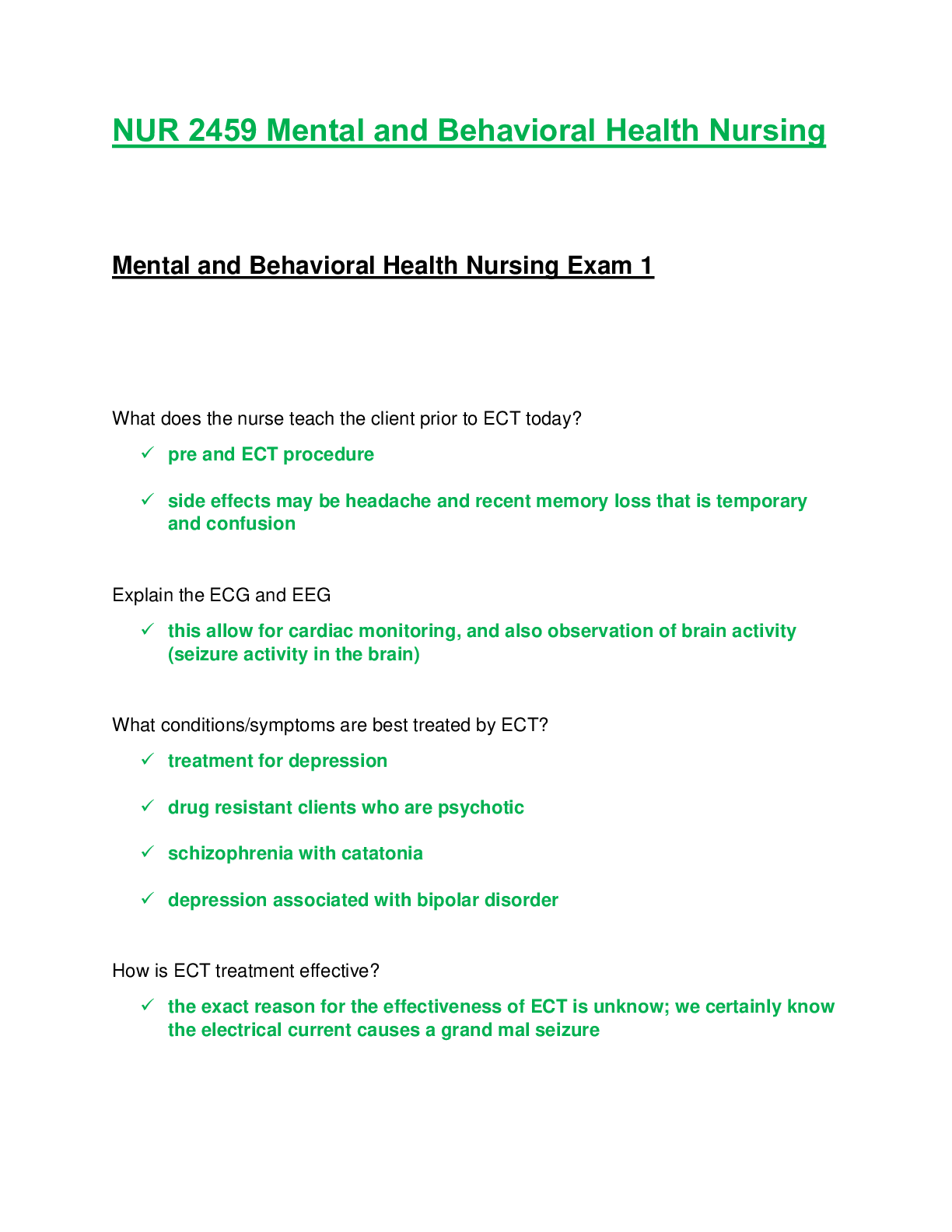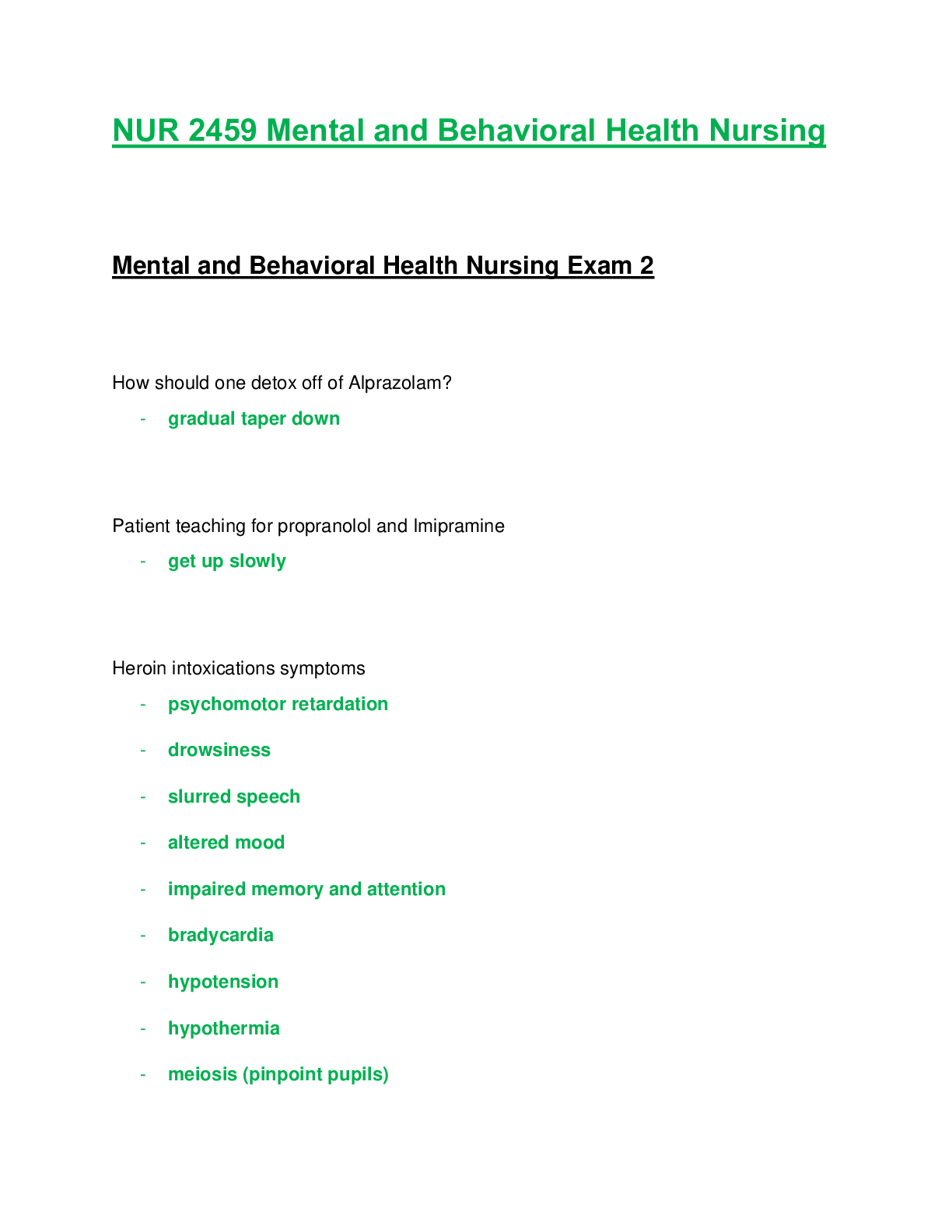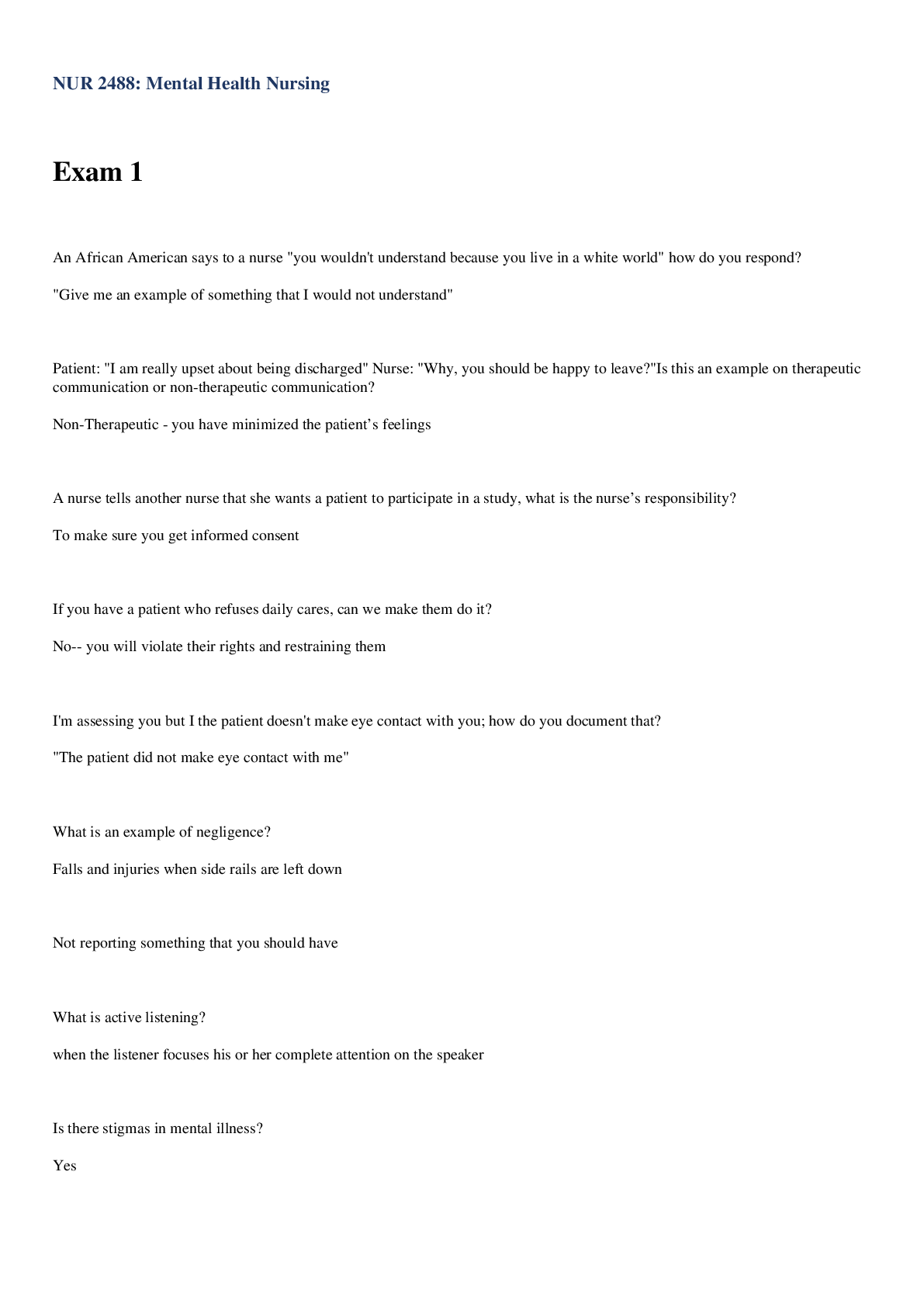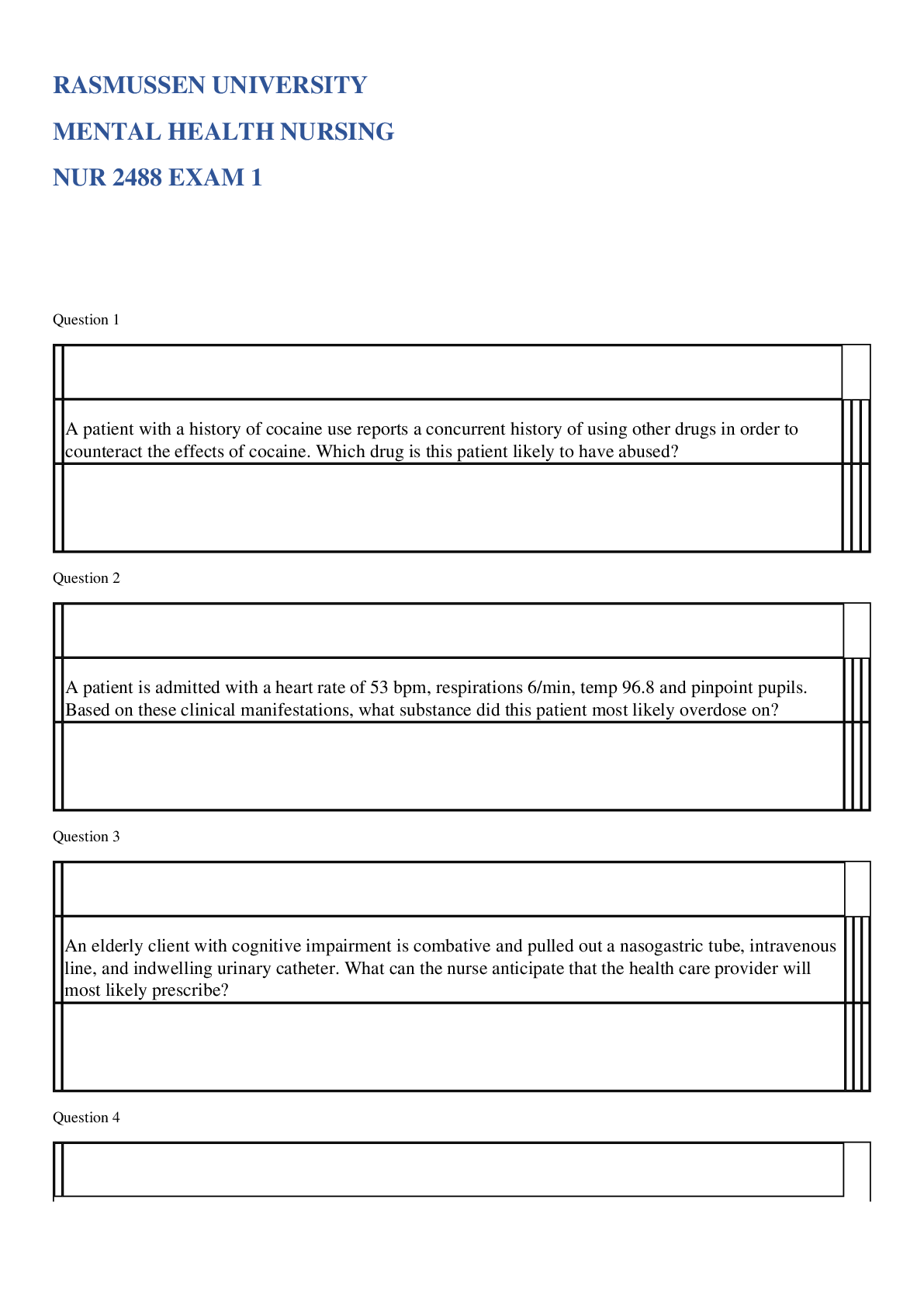*NURSING > EXAM > NUR2488 Mental Health Nursing Exam 3 (50 Verified Answers, already graded A) (Latest 2021/2022): Ras (All)
NUR2488 Mental Health Nursing Exam 3 (50 Verified Answers, already graded A) (Latest 2021/2022): Rasmussen College
Document Content and Description Below
NUR2488 Mental Health Nursing Exam 3 • Question 1 A patient with a history of cocaine use reports a concurrent history of using other drugs in order to counteract the effects of cocaine. Which dr... ug is this patient likely to have abused? Answers : Response Feedback: PCP Alcohol Methylphenidate Caffeine Alcohol is a depressant which can neutralize the effects of cocaine, which is a stimulant. Caffeine, methylphenidate (used to treat ADHD) and the illegal drug PCP are also stimulating and would only exacerbate the effects of cocaine. • Question 2 A patient is admitted with a heart rate of 53 bpm, respirations 6/min, temp 96.8 and pinpoint pupils. Based on these clinical manifestations, what substance did this patient most likely overdose on? Answers : Response Feedback: Opioids Alcohol Marijuana Amphetamine Opioids include prescribed medications such as oxycodone and morphine, and the illegal substance heroin. The above symptoms are typical of opioid overdose, but are not typically seen with marijuana, alcohol or amphetamines. • Question 3 An elderly client with cognitive impairment is combative and pulled out a nasogastric tube, intravenous line, and indwelling urinary catheter. What can the nurse anticipate that the health care provider will most likely prescribe? Answers: A small dose of a selective serotonin reuptake inhibitor A large dose of a benzodiazepine Response Feedback: A maintenance dose of buspirone A small dose of an atypical antipsychotic Aggressive behavior can be safely managed by antipsychotic medication. Initial dosing should be small and raised cautiously until behavior is controlled. Selective serotonin reuptake inhibitors are not indicated for aggressive behavior. If a benzodiazepine is used, the initial dose should be low. Buspirone is not effective if given on an as-needed basis. It is administered in small divided doses daily to control agitation. • Question 4 A nursing care plan contains the intervention “monitor for complications of refeeding syndrome.” Which body system should a nurse most closely monitor for clinical manifestations of dysfunction? Answers : Response Feedback: Renal Central nervous Endocrine Cardiovascular Refeeding resulting in too-rapid weight gain can overwhelm the heart, resulting in cardiovascular collapse; thus focused assessment becomes a necessity to ensure patient physiological integrity. The other body systems are not initially involved in the refeeding syndrome. • Question 5 Which of the following is the best example of all-or-nothing thinking, a common cognitive distortion of patients with an eating disorder? Answers : “If I gain any weight, I’ll keep going until I’m huge.” “When people tell me I’m looking better, they really mean I’m fatter.” “No one likes me because I’m fat.” “When I’m thin, I’m perfect.” Response In all-or-nothing thinking, the person cannot see any middle ground between Feedback: extremes; a person with an eating disorder will see themselves as either thin or immense. The other comments are common in eating disorders but are not examples of all-or-nothing thinking. • Question 6 A nurse reports to the interdisciplinary team that a patient with an antisocial personality disorder lies to other patients, verbally abuses a patient with Alzheimer’s disease, and flatters the primary nurse. This patient is detached and superficial during counseling sessions. Which behavior most clearly warrants limit setting? Answers : Response Feedback: Lying to other patients Flattering the nurse Verbal abuse of another patient Detached superficiality during counseling Limits must be set in areas in which the patient’s behavior affects the rights of others. Limiting verbal abuse of another patient is a priority intervention. The other concerns should be addressed during therapeutic encounters. • Question 7 Which of the following are primary characteristics of a person with borderline personality disorder? Answers : Response Feedback: Demonstrates flexibility and compromise Demonstrates socially appropriate behaviors Demonstrates eagerness to learn new coping skills Demonstrated a self-defeating cycle of behavior A self-defeating cycle of behavior is a hallmark of borderline personality disorder, creating difficulties is work, social and family relationships. Individuals with a borderline personality are inflexible and do not compromise easily. Socially inappropriate behavior is common in borderline personality, as is an unwillingness to change and learn new coping skills • Question 8 A nurse is working with a patient with a histrionic personality disorder. Which of the following nursing interventions must be implemented throughout the inpatient stay? Answers : Response Feedback: Setting appropriate limits on maladaptive behaviors Offering relationship advice Providing multiple options when the patient makes frequent requests Having the patient approach different staff members for interpretation of unit rules Setting firm limits and maintaining consistency are essential elements in working with people with personality disorders. Flexibility and providing too many choices does not help the individual with boundaries and limits. Offering relationship advice is not professional behavior and can have a negative effect on the nurse-client relationship. Encouraging the patient to attend daily activities may be a part of the care plan, but is not as high of a priority as setting limits • Question 9 A patient has blindness related to conversion disorder. In order to assist the patient with eating, which of the following interventions should the nurse implement? Answers : Response Feedback: Establish a “buddy” system with other patients who can feed this patient at each meal. Expect the patient to feed himself after explaining arrangement of the food on the tray. Address the needs of other patients in the dining room, then feed this patient. Direct the patient to locate items on the tray independently and feed himself unassisted. The patient is expected to maintain some level of independence by feeding self, while the nurse is supportive in a matter-of-fact way. The distracters support dependency or offer little support. • Question 10 A patient is admitted for psychiatric observation after being arrested for breaking windows in the home of a former girlfriend who had refused to see him. His history reveals childhood abuse by a punitive father, torturing family pets, and an arrest for disorderly conduct. Which nursing diagnosis has priority in the plan of care? Answers : Response Feedback: Risk for injury Post-trauma syndrome Disturbed thought processes Risk for other-directed violence The defining characteristics for Risk for other-directed violence include a history of being abused as a child, having committed other violent acts, and demonstrating poor impulse control. The defining characteristics for the other diagnoses are not present in the scenario • Question 11 A patient is referred to the mental health center by the family health care provider. Over the past year, the patient has cooked gourmet meals for family members, but eats only tiny portions of the food. The patient wears layers of loose clothing, saying, “It’s just my style.” The patient’s weight has dropped from 130 to 95 pounds. The patient has amenorrhea. Which medical diagnosis are the history and symptoms are most consistent with? Answers : Response Feedback: Anorexia nervosa Bulimia nervosa Binge eating Eating disorder not otherwise specified Overly controlled eating behaviors, extreme weight loss, amenorrhea, preoccupation with food, and wearing several layers of loose clothing to appear larger are part of the clinical picture of an individual with anorexia nervosa. The individual with bulimia usually is near normal weight. The binge eater is often overweight. The patient with eating disorder not otherwise specified may be obese. • Question 12 A patient sat in silence for 20 minutes after a therapy appointment. The patient appeared tense and vigilant. The patient abruptly stood up and paced back and forth across the day room, clenching and unclenching his fists. Next, he stopped and stared intently into the face of a psychiatric technician. Which of the following best explains the nurse’s observations of this patient? Answers : Response Feedback: The patient is demonstrating withdrawal The patient is working off angry feelings. The patient is using relaxation strategies effectively. The patient is exhibiting clues to potential aggression. The description of the patient’s behavior shows the classic signs of someone whose potential for aggression is increasing. • Question 13 A patient referred to the eating disorders clinic has lost 35 pounds during one summer. Which of the following questions would be best if the nurse wished to assess the patient’s eating patterns? Answers : Response Feedback: “Do you often feel fat?” “Who plans the family meals?” “What do you eat in a typical day?” “What do you think about your present weight?” Although all the questions might be appropriate to ask, only “What do you eat in a typical day?” focuses on the patient’s eating patterns. Asking if the patient often feels fat focuses on distortions in body image. Questions about family meal planning are unrelated to eating patterns. Asking for the patient’s thoughts on present weight explores the patient’s feelings about weight. • Question 14 When a victim of sexual assault is discharged from the emergency department, which of the following interventions should the nurse perform? Answers : Notify the patient’s family of the event to seek support for the patient Provide referral information verbally and in writing Offer to stay with the patient until stability is regained Advise the patient to try not to think about the assault Response Feedback: Immediately after the assault, rape victims are often disorganized and unable to think well or remember what they have been told. Written information acknowledges this fact and provides a solution. The remaining options violate the patient’s right to privacy, evidence a rescue fantasy, and offer a platitude that is neither therapeutic nor effective. • Question 15 A patient admitted for a heroin overdose received naloxone, which improved her breathing pattern. Two hours later the patient reports muscle aches, abdominal cramps, and gooseflesh, and says, “I feel terrible.” Which is the correct analysis of this assessment? Selected Answer: The patient should be monitored closely for seizures Answers: A peculiar reaction to naloxone is occurring The patient should be monitored closely for seizures The patient is experiencing a relapse Symptoms are present due to abrupt cessation of narcotic Response Feedback: The symptoms given in the question are consistent with narcotic withdrawal. Early symptoms of narcotic withdrawal are flulike in nature. Seizures are more commonly seen in alcohol withdrawal syndrome. • Question 16 A health care provider writes these new prescriptions for a nursing home resident: 2-g sodium diet; restraints as needed for behavioral problems; limit fluids to 2000 mL daily; continue antihypertensive medication; milk of magnesia 30 mL orally one time as needed if no bowel movement for 3 days. Which of the following is most appropriate for the nurse to do first? Selected Answer: Clarify the order for restraints Answers: Clarify the order for fluid restriction Clarify the order for restraints Transcribe all orders as written Clarify the order for milk of magnesia Response Feedback: Restraints may be imposed only on the written order of the health care provider that specifies the duration during which the restraints can be used. The Joint Commission guidelines and Omnibus Budget Reconciliation Act regulations also mandate a number of other conditions that must be considered and documented before restraints are used. The other orders would be considered appropriate for implementation. • Question 17 The son of an elderly client with dementia is talking to the nurse about discharge. He indicates that his father’s physician has given him 48 hours to decide on a living situation. The nurse discusses possible living arrangements and provides contact information. The nurse knows that the son requires further teaching when he says: Selected Answer: I want the social worker to decide if he should stay home or go to assisted living so he doesn’t blame me. Answers: I have quite a decision to make. I want the social worker to decide if he should stay home or go to assisted living so he doesn’t blame me. Well I guess we can try him at home and if it doesn’t work out, I can move him to assisted living later. I think Dad would rather be at home and I think my sister and I can do it. We’ll talk to this home care agency. Response Feedback: The son is avoiding making a decision and taking responsibility if he states that he wants the social worker to make the decision. Admitting that he has a difficult decision to make, realizing that he can change the living situation when needed, and making a decision to try home care are all healthy comments in this situation and show that he is accepting responsibility and is willing to make a decision. • Question 18 A child with ADHD will begin medication therapy. Which of the following classifications of medications should the nurse prepare to teach the patient and family about? Selected Answer: Central nervous system stimulants Answers: Central nervous system stimulants Monoamine oxidase inhibitors (MAOIs) Antipsychotic medications Response Feedback: Anxiolytic medications Central nervous system stimulants, such as methylphenidate and pemoline (Cylert), increase blood flow to the brain and have proved helpful in reducing hyperactivity in children and adolescents with ADHD. The other medication categories listed would not be appropriate • Question 19 Which of the following nursing interventions is the highest priority while working with a patient who has a somatoform disorder for the first time? Selected Answer: Assess for objective data to support the patient’s report of each physical symptom. Answers: Help the patient shift focus from somatic symptoms to feelings. Imply that somatic symptoms are not real. Help the patient suppress feelings of anger. Assess for objective data to support the patient’s report of each physical symptom. Response Feedback: Physical symptoms need to be investigated with the first patient encounter to rule out an underlying medical condition as cause of the reported symptoms; however, they do not need to be re-investigated each time the patient reports them. Shifting the focus from somatic symptoms to feelings or to neutral topics conveys interest in the patient as a person rather than as a condition, but this is accomplished after ruling out a serious medical condition. The need to gain attention with the use of symptoms is reduced over the long term. A desired outcome would be that patient would express feelings, including anger if it is present. Once physical symptoms have been investigated, they do not need to be reinvestigated each time the patient reports them. • Question 20 The nurse is assessing a pat...........................................................continued [Show More]
Last updated: 1 year ago
Preview 1 out of 25 pages
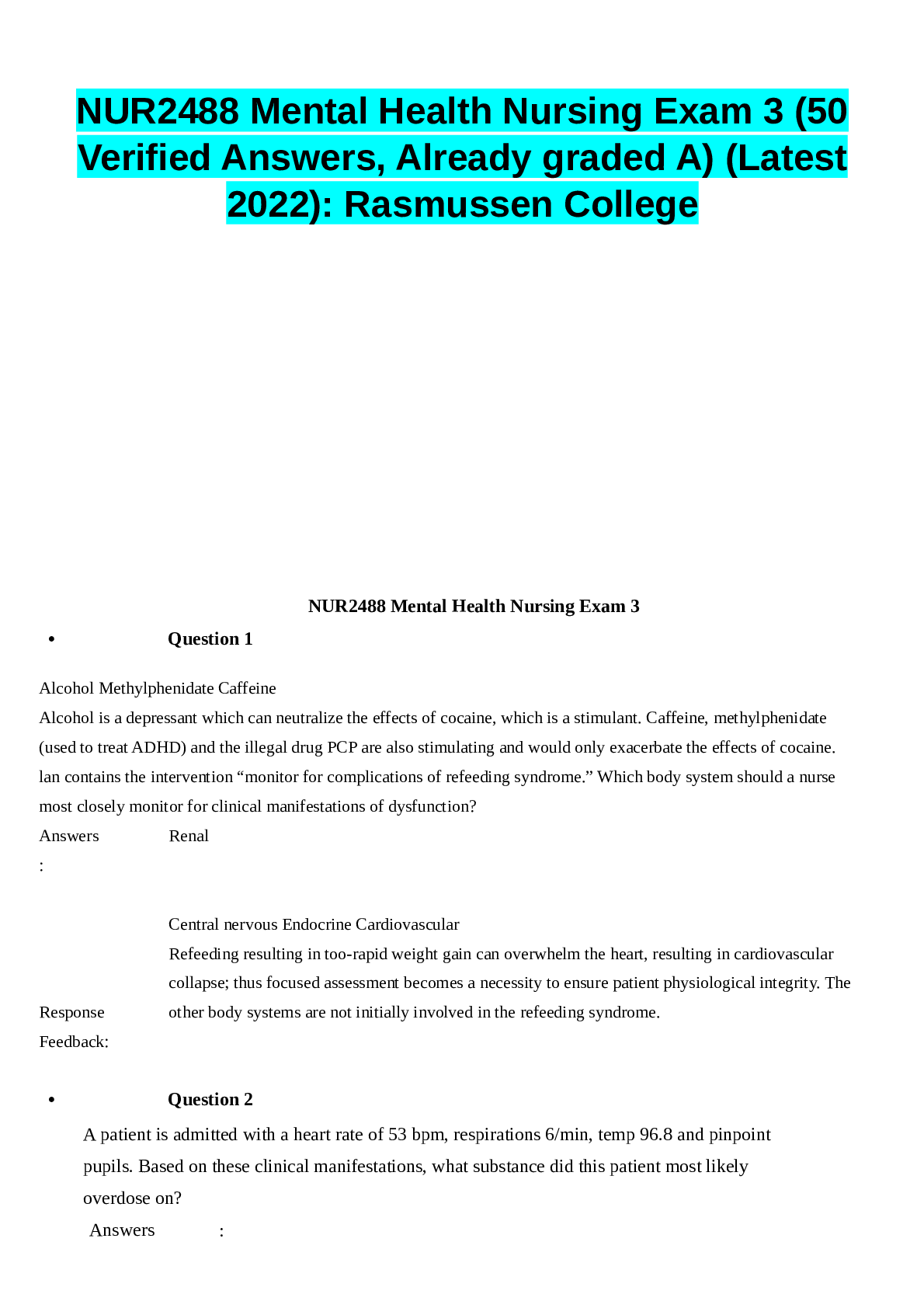
Reviews( 0 )
Document information
Connected school, study & course
About the document
Uploaded On
Feb 23, 2022
Number of pages
25
Written in
Additional information
This document has been written for:
Uploaded
Feb 23, 2022
Downloads
0
Views
39

